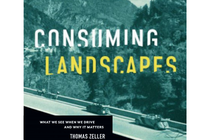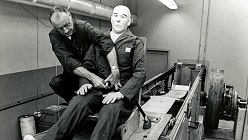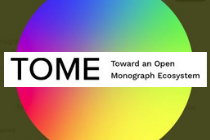By Jessica Weiss ’05
A deadly public scourge. A fight pitting government safety mandates against personal freedom. And over time, growing popular acceptance of a solution that was a shot in the arm for public health.
If this sounds like the COVID-19 vaccine controversy, think again. Beginning in the 1950s, engineers, drivers, passengers, regulators and politicians in the United States entered into highly charged deliberations over whether seat belts and speed limits should become mandatory. Today most of the country has 90% seat belt use, and a University of Maryland historian is digging into the historical controversy with an eye to its present-day echoes.
“It’s hard now to imagine a time when seat belts would be controversial, but there was a vivid, expensive and passionate debate about road safety and the lack thereof,” said Associate Professor Thomas Zeller, a specialist in environmental history and the history of technology.
Zeller was recently named a 2022–23 Arthur Molella Distinguished Fellow at the Smithsonian Institution’s Lemelson Center for the Study of Invention and Innovation and will start in September on a project to explore this history. He will have access to the National Museum of American History’s artifacts, archival collections and library resources, including physical seat belts and guidebooks on highway safety.
Airplane pilots had already been using seat belts for decades when the push to make them standard in cars began to take hold in the 1950s. By 1955, some 100 people were dying on the roads each day. Despite increasing public health research showing that seat belts saved lives in crashes, many people argued against them, focusing on their potential to cause internal injuries or to make it more difficult to escape a burning or submerged car. Other opponents said that regardless of safety implications, it should be a personal choice instead of a requirement.
In a 1966 speech, former President Lyndon Johnson dubbed the high number of deaths on the nation’s roads “the highway disease.” Laws that began to require seat belts in the 1960s—including a federal law requiring “lap and shoulder belts” in all new cars starting in 1968—were portrayed by some as attacks on personal liberty. Critics of laws that instituted fines for not buckling up in the 1980s likened them to encroaching totalitarianism. At the time, only 14% of Americans used seat belts.
Zeller plans to examine scores of archived letters to the editor commenting on proposed laws and mandates from the 1960s to the 1980s. He’ll also explore the role of several public safety campaigns, such as those featuring famed crash test dummies Vince and Larry. The dummies are part of the National Museum of American History collections, along with seat belts, alcohol detection devices and other objects related to automobile safety.
He said exploring this history will shed light on the present, as Americans are once again divided on how much power the government should have to protect public welfare, even if it means taking away rights.
In recent months, some doctors and public health officials have even compared vaccines to seat belts in their ability to significantly decrease the risk of COVID-19.
“The story of public health is sometimes about doing something for the collective good that requires individuals to change their behavior,” Zeller said. “And that’s the underlying tension.”







